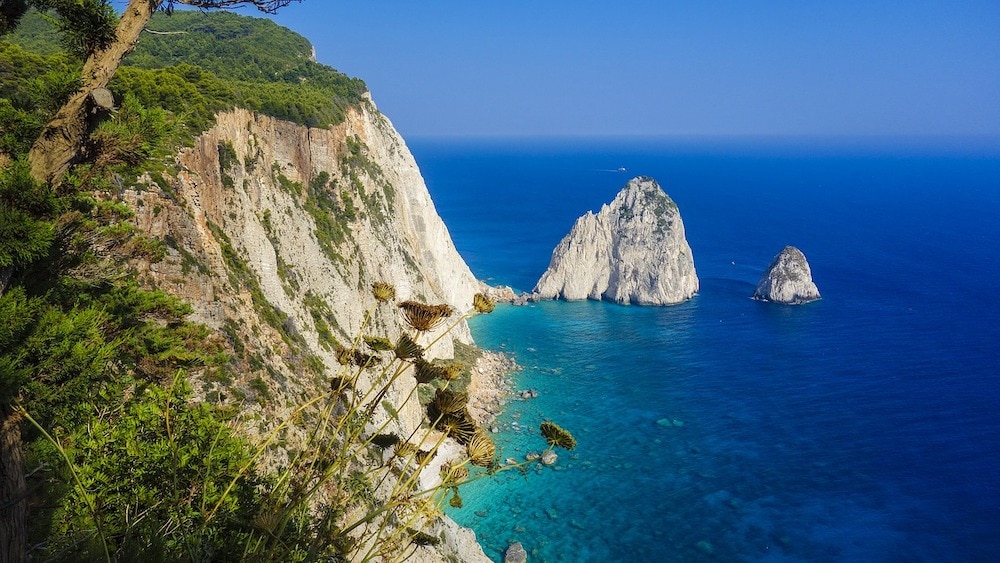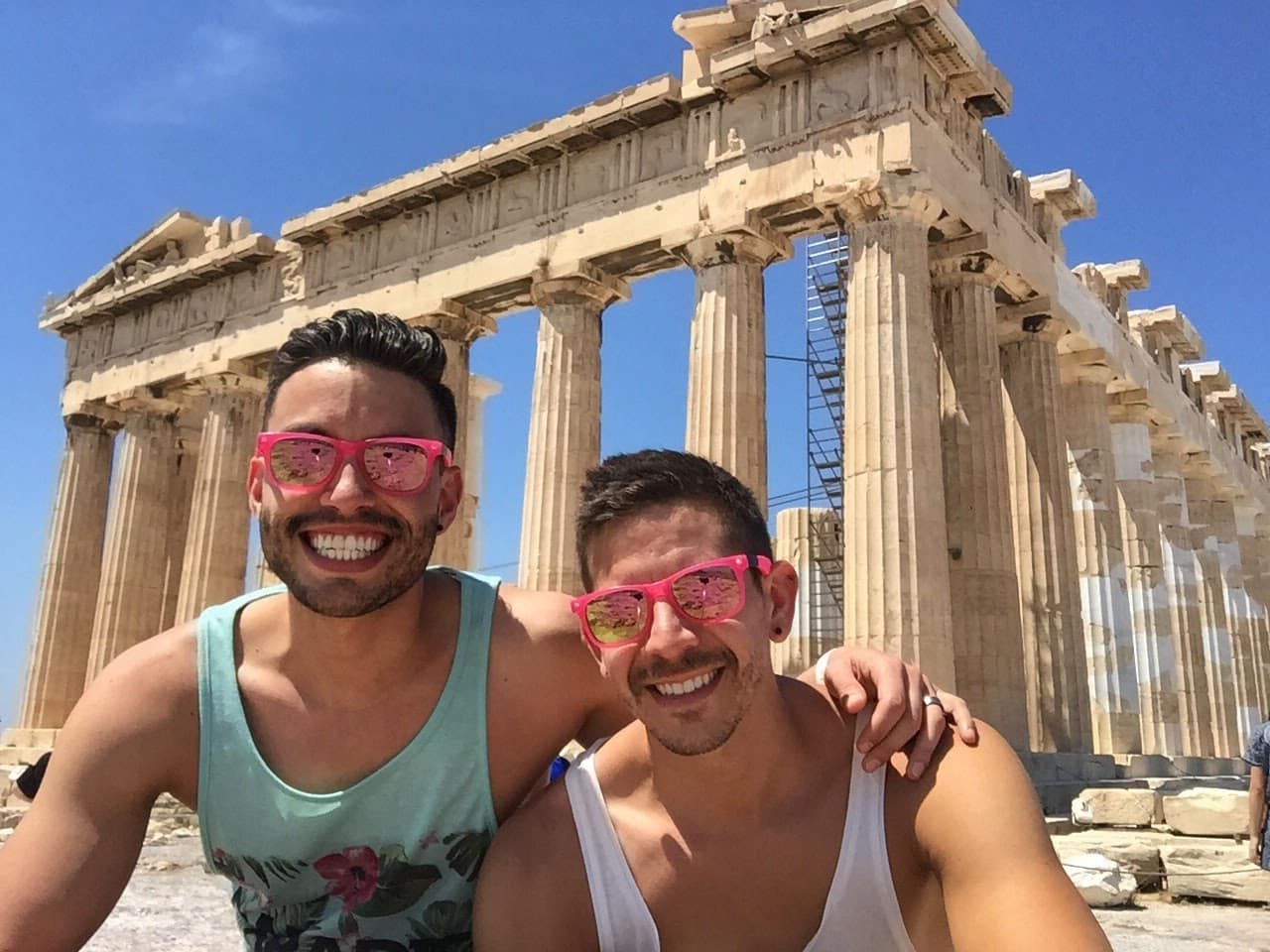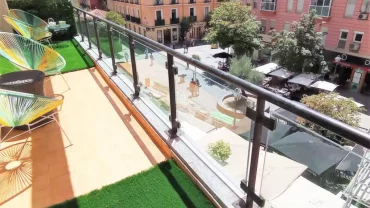Greece is a popular European summer destination, and taking a trip to the mainland or one of the Greek islands is on many travelers’ bucket lists—a lot of foreigners are even moving there indefinitely. Greece is, hands down, one of the most beautiful countries to visit in Europe, offering a wide range of diversity in its landscapes, attractions, and gastronomy.
Same-sex sexual activity has been legal in Greece since the 1950s, and anti-discrimination laws for employment have been in place since 2005. As of February 2024, Greece made the momentous achievement of becoming the first Orthodox-majority country to legalize same-sex marriage and grant gay couples the right to adopt. Finally, Greece is making strides in the right direction toward LGBTQ+ equality after previously lagging behind its Western European neighbors.
Besides its history (and food, of course!), Greece is probably most famous for its islands. There are more than 6,000 islands that are part of Greece, with roughly 200 being inhabited. Selecting which island to visit can be overwhelming unless you narrow down your parameters. While you can find a variety of offerings across the different islands, it’s best to choose the kind of experience you’d most like to have. Though you might not expect it, the islands vary greatly, and you can find everything from nature and landscapes, party or relaxation, luxury to budget, history, gastronomy, and water activities. Most of the main islands are connected by a network of ferries, and some of the larger ones even have airports.
After visiting Greece many times in the past few years, we’ve come up with a list of our top five destinations for LGBTQ+ travelers. While Greece may not be as progressive as some countries in Western Europe regarding LGBTQ+ rights and widespread acceptance, these five destinations are definitely among the most welcoming. Of course, Mykonos is the quintessential gay haven in Greece, but LGBTQ+ visitors will also find great options and welcoming locals in all five locations.
Athens
Athens is known for its rich historical and cultural relics. Ruins, ancient architecture, and a beautiful landscape make this journey to the cradle of civilization a breathtaking one. Athens is a place you have to see at least once in your life. The Parthenon atop the Acropolis is a must-visit attraction and historical site, and an accompanying visit to the Acropolis Museum is a great choice to fully immerse yourself in its history. At the Acropolis, you experience history in its truest form by stepping back in time and exploring these awe-inspiring ruins.
Though not typically known as a gay destination, Athens attracts all kinds of travelers who come to immerse themselves in the city’s renowned history. Many LGBTQ+ visitors may simply pass through the city on their way to more gay-friendly Greek destinations like Mykonos, but it would be a mistake to skip Athens entirely or only drop in to catch a glimpse of the Parthenon on the way to a more relaxing beach town.
Gazi is one of the most popular neighborhoods, and you’ll find plenty of gay and gay-friendly venues in this area. Over time, it has become slightly less gay-focused as it has become gentrified, but as a first-time visitor, it’s still the place to start. It’s important to note that the gay scene in Athens is more low-key compared to gay hotspots like Mykonos. Additionally, the scene here is much more local and operates year-round, as opposed to being seasonal and tourist-driven like on the islands. As the capital city of Greece, with nearly 4 million people in the metro area, you’ll find a large selection of gay and gay-friendly restaurants, cafes, bars, and clubs.
Pride in Athens is not the biggest or most progressive pride you’ll find in Europe, like those in Stockholm, Madrid, or Berlin. It’s still a mix between being a political event and a celebration of LGBTQ+ equality. However, it’s a fun and interesting event worth planning a trip around if you have some flexibility.
Along with the Parthenon, there are other historical sites near Athens that are worth visiting, such as taking a day trip to the ancient theater of Delphi, which offers stunning views of the landscapes below. Finally, Mystras is another nearby option that holds the ruins of carefully crafted medieval buildings, also set in a fantastic landscape.
Mykonos
Mykonos is the most popular Greek island for LGBTQ+ travelers. Beautiful beaches, white-painted buildings framed with blue windows, beachfront shops, restaurants, and wild summer parties attract many LGBTQ+ visitors seeking a mix of rest and relaxation, as well as party and pleasure. One of the most popular and biggest gay events is XLSIOR , described as Europe’s hottest annual summer gay circuit festival. Like most Greek islands, Mykonos comes alive with crowds from June through September, but if you prefer to avoid the crowds, stick to visiting between the end of May and early September.
Mykonos Town is the main transport hub on the island and the area where most people stay. It’s a picturesque place, with white-painted houses that reflect the strong sun and characteristic blue church domes. There are also a few gay hotels in Mykonos, along with many gay-friendly options. The Mykonos Grand Hotel and Resort is one of the largest and most luxurious, occupying 20 acres of landscaped gardens just three miles from Mykonos Town. Alternatively, the Poseidon Hotel Suites iis perfectly located, offering views of the Mykonos Windmills, 500 meters from the gay nightlife and above Megali Ammos Beach.
The old town is impressive, with Little Venice lining the water, and its gay beaches are great for relaxing and mingling. Mykonos offers countless things to do, but with the island's popularity and overdevelopment come crowded streets, packed beaches, and extremely high prices. We won’t tell you not to visit Mykonos because of this—frankly, you should, and you’ll probably love it, especially given how gay-friendly it is. Remember, it’s popular for a reason.
Besides Santorini, which is probably the most popular and touristy island, Mykonos likely holds the title of second for general visitors but definitely takes the lead as the top Greek island gay hotspot. Mykonos has been a getaway for the gay community for decades, as it became more open and liberal than Athens and the surrounding islands.
Mykonos is part of the Cyclades group of islands, as are other popular spots like Santorini, Naxos, Milos, Ios, Delos, and Paros. Each island has its own unique vibe and culture, and you likely won’t be disappointed with any choice. If you’re already planning a visit to Mykonos, it’s practical to choose another island in the same group to visit before or after, by catching one of the many ferries to complete your trip.

Santorini
Santorini is another island in the Cyclades group and is probably Greece’s most famous and well-known island. This ancient volcanic island has cities and towns that seem like they should only exist in storybooks. Throughout the island, you’ll find amazing views, stunning natural wonders, secluded seaside villages perched on cliffs, and well-preserved ancient Greek historical sites. If you arrive in Santorini by ferry, you’ll need to take a shuttle bus up to the city where you’re staying. Most visitors stay in either Oia or Fira, which are the main cities on the island. Santorini does have a small airport, but flights are generally quite expensive and most connect through Athens. Island hopping around the Cyclades is easily done by taking a ferry from one port to the next, and including Santorini on a trip to several islands is a great option to round out your visit to Greece.
Santorini is a perfect escape from the party scene after you’ve binged in Mykonos for days and need a much-needed detox. However, it is important to note that due to its popularity, the island can often feel overcrowded in the peak summer months, particularly when cruises are in port and people are visiting for a day trip. The evenings in Santorini definitely quiet down as a large portion of the cruise tourists leave the island to head back onboard for their next stop. Santorini has a wide range of accommodations, but probably fewer budget-style backpacker hostels, as it’s not really a party island attracting that crowd. Due to its popularity, prices for everything are high, similar to or even higher than what you might pay in Mykonos.
Fira, the capital of Santorini, is full of whitewashed buildings perched all along the 400m-high cliff. These buildings, which line the cobblestone streets, consist of shops, hotels, taverns, cafes, and homes. The sunsets seen here are said to be some of the most striking in the world. As warm colors of red, yellow, purple, pink, and orange fill the sky, they paint the white buildings in the same hues. Arrive in the early evening to get a good table at one of the many bars to enjoy the sunset with a cocktail before heading out to dinner in the area.
Ios
Ios has historically been known as a party island, and its popularity began a few decades ago when backpackers and local Greeks visited during the summer months, slept on the beach, and partied all day and night. Though the island still has its fair share of beachside bars and clubs, the vibe has shifted slightly over the years. Ios has not been overdeveloped like some other islands, so the atmosphere remains relaxed, and prices are much lower than traditional destinations like Mykonos or Santorini.
There are plenty of budget-friendly places on the island, including hostels or simple private rooms for just €50 per night. High-end properties like Agalia Luxury Suites or Liostasi Hotel give visitors additional options if you're looking to splurge. Most luxury properties provide transfers from the port and may even offer rides to various parts of the island.
If you want to be part of the Ios vibe, you should stay in the heart of the action near the old town, the port, or Mylopotas Beach—probably the three most visited areas on the island. The most popular beach on Ios is Mylopotas, and this area offers plenty of restaurants, bars, clubs, and water activities. Unlike Mykonos, you won’t find any gay-specific venues, but the atmosphere is open and gay-friendly overall.
One must-see attraction is an evening visit to Pathos —a sunset bar perched on the edge of rocky cliffs, perfectly aligned for watching the sunset. The design is artistic and fresh, the cocktails are delicious, and the sunset is one of the most stunning you’ll ever witness. Arrive just before sunset for a fantastic experience with a few cocktails before heading out to dinner.
Great food can be found throughout the island, but our favorite spot is easily a cute little place in the old town called Katogi. Owned by a young Greek couple, the restaurant is tucked into a small alley, offering outdoor dining, and the food is out of this world.
On the far end of the island, you will even find the tomb of Homer, which pays tribute to the famous Greek poet. Though historians debate whether this is his true burial place, it’s undisputed that Homer spent many years living on Ios in ancient times. The tomb itself isn’t overly impressive, but the views from the lookout point at the tomb are remarkable.

Crete
There are so many Greek islands popular with tourists, especially the smaller ones in the Cyclades. While many of these can offer a fantastic experience of Greek island life, many lack the infrastructure and range of things to do that a larger destination would have. Crete, on the other hand, has something of everything and with a population of over half a million spread over more than 8,000 square kilometres, has enough going on that you won’t get bored while still not being too busy to enjoy the beaches, landscape and cities.
Given its size, Crete has a lot to offer. With hundreds of kilometres of coastline it has pristine beaches including some very secluded and hidden ones. There are plenty of opportunities to enjoy the island’s gorgeous weather, but there’s also a ton to keep you busy off the beaches too. The two main cities on Crete, Heraklion and Chania, both along the north coast, offer a lot in the way of culture, including museums, art galleries and theatres as well as plenty of shopping opportunities, nightlife and sporting events. Though it’s relatively large, there’s an extensive network of buses that connect all of Crete’s main towns and most of the smaller villages. Chania is a beautiful destination choice to visit and the Old Port of the city was built by the Venetians in the 14th century. It’s a great place to stroll along the sea and enjoy one of the many restaurants, cafes and shops.
Like the rest of Greece, Crete is full of history. But it is also the home to many unique and important historical finds and sights that can’t be seen anywhere else in the world. Humans have been present on Crete for more than five million years, and since then, relics of many cultures have been left behind, including the Minoans, Myceans, Romans, Byzantines, Arabs, Venetians and Ottomans. Top places for history buffs not to miss include the Heraklion Archaeological Museum, the Palaces of Knossos and Malia, Phaestos, the Fortezza and the Koules Fortress.







Comment (0)